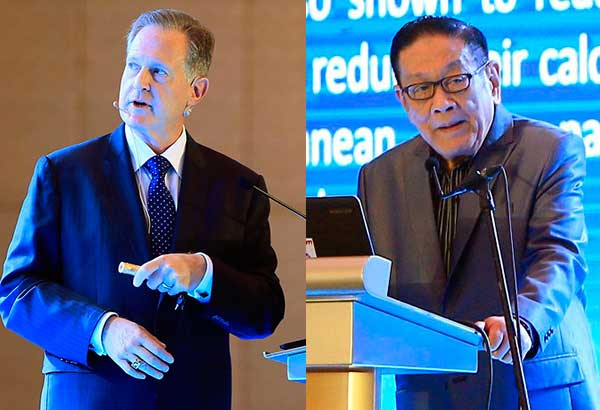Fat will not make you fat

Dr. Augusto D. Litonjua and Dr. Robert H. Lustig
The big fat fact is that a lot of us avoid fat like the plague. So, we drink fat-free milk and will only eat what’s fat-free or low-fat or cholesterol-free, or foodstuff with “reduced fat” or “50-percent less fat.”
We’re all sitting snugly in a function room of a five-star hotel, content in the thought that we’re eating right, until the guest speaker, Dr. Robert H. Lustig, Division of Endocrinology, Department of Pediatrics, Institute for Health Policy Studies, University of California, San Francisco, jolts us nearly off our seats with his declaration, “Fat will not make you fat.”
Fact is, so Dr. Lustig stresses, fat is essential in our diet as it provides the energy we need for most of life’s functions — for our brains and nerves to function properly. Our brains contain huge amounts of essential fats. Just think about it.
What’s making us fat?
So, what is making us (or more than a third of adult Americans) fat or, worse, obese?
Want to take a fat guess?
At this press conference dubbed “Fats and Sugars: Friends or Foes?” and organized in partnership with United Laboratories, Inc. (Unilab), the leading pharmaceutical and healthcare company in the Philippines, we track down the real culprit. Why, it’s the sugar!
Now that’s enough to keep our hands off the sinful desserts on the buffet table, tempting our sweet tooth. (But as soon as Dr. Lustig leaves the room, we succumb to the sweet temptation.)
With pangs of guilt, we learn that the Philippine Center for Diabetes Foundation (PCDEF) is seriously urging public and private medical practitioners and institutions to step up efforts to educate Filipinos on the health risks posed by too much consumption of products containing fructose.
What is fructose? It’s a type of sugar found in fruits and sweetened food products and beverages, which, according to Dr. Augusto D. Lintonjua, PCDEF founder and president, could cause conditions associated with the so-called metabolic syndrome.
What is metabolic syndrome? It’s a cluster of conditions that increase a person’s risk for heart diseases, stroke, and diabetes. These conditions include obesity, high blood pressure, high blood triglycerides, low levels of HDL (or the good) cholesterol, and insulin resistance.
What makes fructose the bad guy? Dr. Litonjua explains that fructose is not easily broken down by the body, thus causing the formation of harmful chemical compounds such as bad fat.
The good doctor relates, “The USDA made a study wherein people thought table sugar was bad, so they removed table sugar and encouraged people to eat fruits. After which, the prevalence of diabetes and obesity went up along with the increased consumption of fruit sugar — the (diabetes and obesity) rate was higher than when Americans were consuming table sugar or glucose.”
Dr. Litonjua goes on to explain, “The reason for that is that fructose is not metabolized by insulin, unlike glucose. Fructose goes to the liver where it is being deposited and the liver turns it into triglyceride, a form of fat storage making the liver fatty with intake of too much fructose.”
Dr. Litonjua blames the lack of proper knowledge of the bad effects of fructose to society’s notion that all fruits are naturally good. The simple fact is fruit sugar is fructose.
What’s worse is consumers are not aware of this chemically produced fructose now popularly used in goods sold on the local market. It’s called high-fructose corn syrup, an alternative sweetener to raw sugar used in the manufacture of sugar-sweetened beverages such as soft drinks and fruit juices.
Dr. Litonjua believes that Filipino consumers should be made aware of the bad effects of high-fructose corn syrup — now before the incidence of diabetes and obesity further escalates.
The fat skinny person
Dr. Lustig says there’s a name (or a term) for it: TOFI (thin on the outside fat on the inside). It’s a term coined by Prof. Jimmy Bell who describes the “fat skinny person” or one who seems normal or even healthy from the outside, but this is only skin-deep — British scientists have found that these TOFIs carry a lot of fat around their organs (visceral abdominal fat). This is the worst fat as it is linked to a host of health risks, such as heart disease, fatty liver, type 2 diabetes, and high levels of bad cholesterol. And the accusing finger is pointing at sugar, specifically fructose, which can lead to increases in visceral fat.
“The food industry definitely wants this to be about the obesity epidemic because they win: You eat too much and exercise too little,” Dr. Lustig discloses. “They will always steer the discussion to the obesity epidemic. It is not about obesity. From now, all of you, take an oath that you will only write about the diabetes epidemic. Because thin people get diabetes, too. And they get it for the same reason that fat people do.”
Consider these big fat facts: Obesity is increasing worldwide by one percent per year while diabetes is increasing worldwide by four percent per year.
Dr. Lustig stoutly asserts, “It’s not about obesity — it’s about metabolic dysfunction, which anyone can get (and of which obesity is a result, not a cause). If we fix the metabolic dysfunction, the obesity will improve.”
Now, that’s the big fat fact!



















